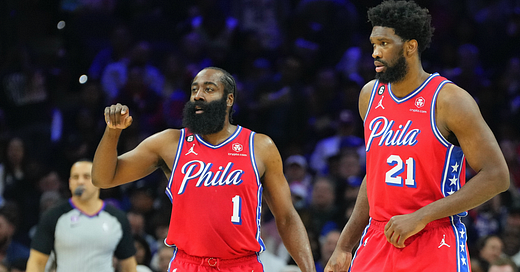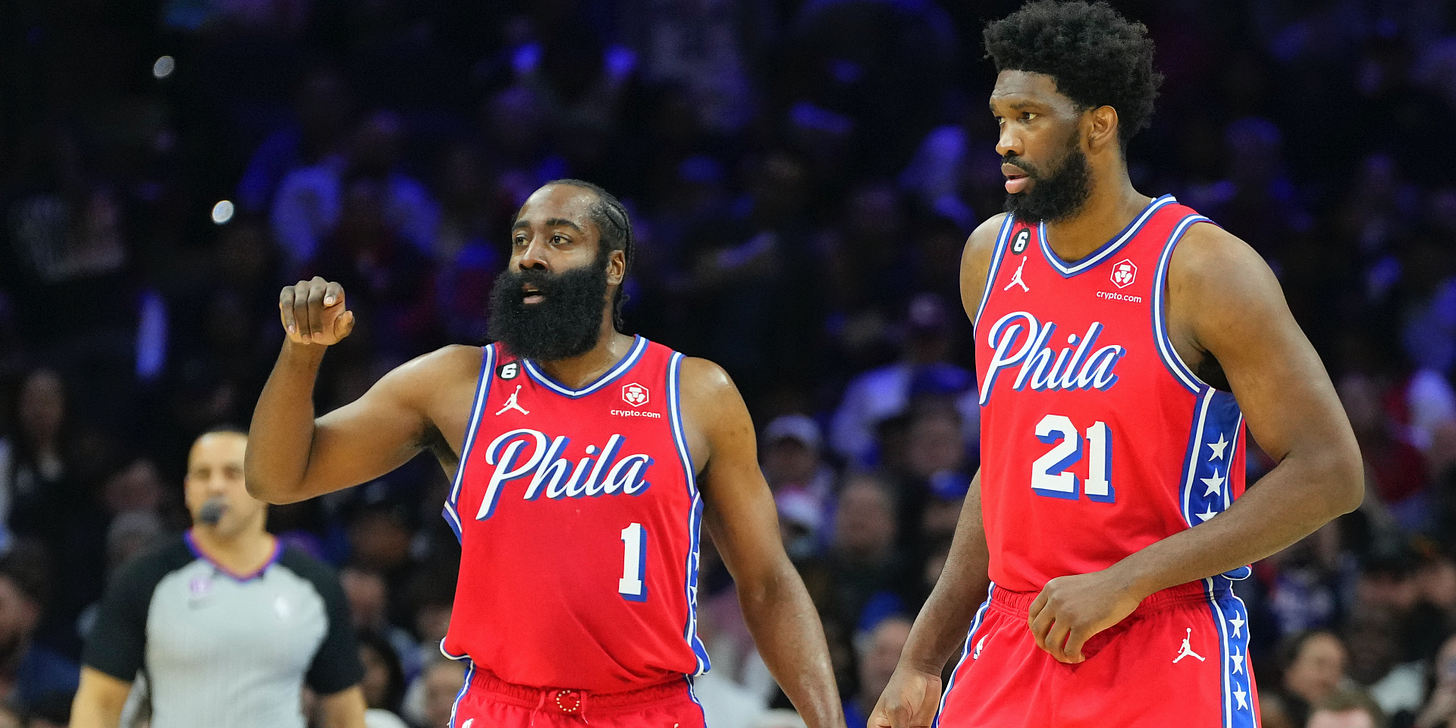Sixers Notes: Harden Watch, Free Agent Targets and Double-Big Lineups
Some old guys, some new guys, and some future guys.
Adam Aaronson, whose legal name is Sixers Adam (@SixersAdam on Twitter), covers the Sixers for The Rights To Ricky Sanchez. He believes cantaloupe is the best food in existence, and is brought to you by the Official Realtor of The Process, Adam Ksebe.
With the Sixers mostly out of the headlines for a few days, this seems like a good time to zoom out for a moment and evaluate a few different storylines worth watching in the remainder of the summer. Let’s do it:
James Harden Watch
People say “patience is a virtue,” but following a painfully dragged-out situation like this one projects to be is going to be much easier said than done. Just about everybody -- myself included -- would love to see the Sixers trade Harden or repair their relationship with him to the point that he rescinds his two-week old trade request so that this confusing ordeal is not at the center of the Sixers universe for the coming months.
Unfortunately for all of us, NBA teams must operate in a fashion which often disregards the desperate hopes of fans and writers. The Sixers are no different. President of Basketball Operations Daryl Morey proved during the Ben Simmons saga -- which ultimately resulted in Harden’s arrival in Philadelphia -- that he will not jump to make a reckless move spurred by impatience or any other emotion.
That leaves all parties involved in an unusual situation -- and each side has a major dilemma on its hands.
Harden wants to be traded, and he wants to be traded to a team prepared to offer him a long-term contract following the 2023-24 season. But right now, it is unclear if such a team even exists. There have been very few indications that the Sixers have had any sort of productive dialogue with the Los Angeles Clippers, the team Harden is currently angling to join. When sorting through every team in the NBA, it becomes difficult to identify any others who would be inspired to make a strong run at Harden.
The Sixers, meanwhile, do not seem willing to commit to Harden in anything beyond the very short-term. Harden’s noticeable decline and repeated issues in the playoffs have left many skeptical of whether or not he can actually be the guy who, in partnership with reigning NBA MVP Joel Embiid, leads this team to a championship. Frankly, there are very few indicators that Harden can be that guy. And yet just about any realistic Harden trade would make next year’s Sixers a worse team than the one that experienced yet another epic collapse in the second round of the playoffs.
For all of these reasons, it feels like the most likely outcome right now is Harden returning to Philadelphia for his second full season with the team. It’s a situation that Harden would not be thrilled with, and I’m not sure the Sixers would be jumping for joy either.
So, how exactly is this situation going to end well for anybody? Your guess is as good as mine.
Mid-Level Exception Targets
While the Sixers may try to avoid using their largest source of free agent spending power until the Harden situation resolves itself, their Taxpayer Mid-Level Exception -- worth up to two years and $10.2 million -- is sitting in their pockets as free agents who could be worth that figure continue to go off the board. If I was in charge, I’d be pushing to use that money now to ensure the team can nab a valuable rotation player before all of them get signed by other teams, and if Harden does get dealt and the fit with new pieces has to be figured out after the fact, so be it.
Additionally, there is zero financial incentive to avoid using the T-MLE -- the Paul Reed contract has officially taken them over the luxury tax threshold, and they can spend all $5 million of the exception this year without even coming close to the new, vaunted second apron which enforces extremely strict roster-building rules.
So, who is still out there and a credible rotation player? As I think about the Sixers’ roster as it stands now, with two spots open, its most glaring hole in terms of depth is a reliable third wing. Right now, Danuel House Jr. is that guy, with Furkan Korkmaz behind him. I like House Jr. more than most, but asking him to be the team’s first wing off the bench may lead to him biting off more than he can chew. Ditto for Korkmaz as the team’s fourth wing, as he has failed to make any noteworthy impact in each of the last two seasons. Finding one more reliable wing allows the team to slot House Jr. into a slightly smaller role that would be easier to imagine him excelling in.
I believe the best wing still available in free agency is Chester, Pennsylvania native Derrick Jones Jr., a high flier who can conceivably play either forward spot -- and even man the middle in an especially small lineup against the right team. Jones Jr.’s athleticism and frame are excellent, enabling him to become a quite useful defensive player.
There is a catch here, though: Jones Jr.’s only consistent offensive ability is as an alley-oop threat, which is not an ideal primary offensive utility for someone who is listed at 6-foot-5. In the last three seasons, he has taken just 4.3 three-point attempts per 100 possessions, and has only made 32.5 percent of them.
Non-shooters or poor shooters can absolutely cement themselves as viable rotation players in the right contexts. New Sixers Head Coach Nick Nurse could foster an environment in which Jones Jr. can succeed, as he has a documented affinity for tremendous athletes dragged down by suspect skill sets.
A more traditional wing option would be Kelly Oubre Jr., whose main calling card at this juncture is his high-volume three-point shooting. Oubre Jr. has the quick trigger, frame and athleticism of a prototypical 3-and-D wing.
The problem is, even when accounting for his massive volume, there is not much evidence that Oubre Jr. is anything more than an average shooter. He has made at least 35 percent of his three-point attempts in just one season in his career, and has shot below 70 percent from the free throw line in two of the last three years.
I bring Oubre Jr. up because he has the kind of physical tools and shot chart that generally intrigue teams these days, particularly Morey, who has coveted that sort of archetype time and time again during his career, and he is someone who at least at some point has been good enough to warrant more than a minimum contract. He averaged over 20 points per game last season, a career high, and that is worth something in theory, even for someone whose true shooting percentage was well below the league average.
Even if his production is overrated in a holistic sense -- which I do believe is the case -- at least Oubre Jr. is capable of getting hot: he scored more than 25 points on 14 separate occasions last season -- for reference, Tobias Harris did this just once during the year, while House Jr. and PJ Tucker have not done in a single time in either of their entire NBA careers.
Neither of these options are perfect -- no option at this price is, generally speaking, especially two weeks into free agency when the market has become depleted. But at least they have theoretical upside -- which is more than most of the remaining free agents could say.
Twin Towers?
Many Sixers fans have been longing to see Reed play next to Embiid, logging power forward minutes. In Reed’s three seasons with the Sixers, he and Embiid have shared the floor for fewer than 75 total possessions. It’s a look that never materialized under Doc Rivers. But, again, Nurse has a propensity for using lineups that look wacky on paper, particularly ones that could overwhelm a team with their length and/or athleticism.
It is unclear if Reed will ever be able to log minutes at the four, a position he has almost never played during his NBA career. However, the Sixers just added a player with more experience in two-big lineups than any other player on the roster -- Embiid included -- and is an easier player to imagine fitting alongside the MVP than Reed.
That player is Mo Bamba, 25, who spent the first 4.5 years of his NBA career on Orlando Magic teams that used two-big lineups on a nightly basis. It was not just something they did, it was something they were reliant on.
Before his first media availability as a Sixer last week at the team’s practice facility in Camden, New Jersey, I planned to ask Bamba if he believed that he and Embiid could share the floor. Before I could ask, he volunteered his belief that he and Embiid -- a mentor of his -- can not just survive, but excel sharing the floor. So I pivoted and asked Bamba what needs to happen for a two-big lineup to play well. Bamba went into tremendous detail for nearly two minutes as he explained how such lineups have changed based on the evolution of the game in recent years, and what the recipe is for a two-big lineup to produce.
“I think the biggest key is -- it’s never offensively. Obviously, like, a little bit of it is spacing. A two-big lineup only really works if you have a back-to-the-basket player as one big, say your five-man, and your four-man needs to be a really good shooter,” Bamba said.
“It’s just spacing. It gets really frustrating when you can’t really go to, like, your jump hook and the paint gets clogged, or you go to your face-up and there’s a guy just standing in the lane…
“Defensively, I think in order to put out a two-big lineup there [needs to be] defensive versatility out there. It could work with two guys in a drop coverage -- it might be a little harder because the direction of the game, a lot of fours… you know, you see a lot more Jonathan Isaac, Jaden McDaniels, even Naz Reid at the four, those guys can really put it down on the floor and do a couple things, as opposed to when I first got into the league, it was kind of more, like, stretch fours who were kind of just kind of pick-and-pop guys,” Bamba continued.
“But defensively, if you have a level of versatility out there with a guy who can switch, who can rim protect, a guy who can do a lot of different things, I think that will definitely help the lineup.”
Can an Embiid-Bamba on-court partnership be a success? Time will tell.






